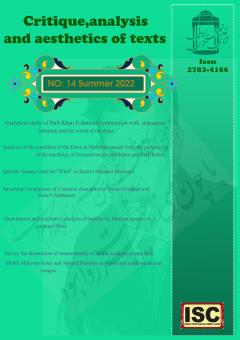Analysis of the condition of the Dave in Marzban-nameh from the perspective of the teachings of Zoroastrianism and Islam and Folk beliefs
Subject Areas : Critique of textsKHodabakhsh Asadollahi 1 , Alireza Kazemiha 2
1 - Professor, Department of Persian Language and Literature, Mohaghegh Ardabili University
2 - PhD student in Persian Literature, Mohaghegh Ardabili University
Keywords: Marzban nameh, Dave, Zoroaster, Islam, Folk beliefs,
Abstract :
Among the ancient Persian literature ,evidences of penetration of the myths of Nations can be found, that indicates the writer’s or poet’s influences are most of these myths. when the writer’s words are exanimated from a mythological point of view; gradually these impacts give them theirs, because from the mythology’s perspective some one who is studing_classical and contemporary texts, if there is an effect of the author from archetype or mythical element, will be realize this factor at writing. In the dyvgavpay(a demon that has a cattle-shaped leg) and religious knowledge story,wich is registered in the fourth chapter of the Marzban nameh , also the same ingredient are visible. Being a negative person called demon, from the time of Zarathustra’s changes among of Iranians, he losts his grand position and , according to the Zoroastrian teachings, has a low and hateful position, on the one hand, in addition has a cattle-shaped leg on the other hand, likewise declaring the text of the mastery the demons initially had on the environment and also, gather all of them by the command of the dyvgavpay, all are elements that can be traced from the point of view of mythology and reading the old texts and the beliefs of the Islamic and Zoroastrians. So in this research we have done it till prove this point that myths ancient Iranian beliefs in the Zoroastrian and Islamic periods and after that, in this text have been impressive.
1- قرآن کریم.1376. ترجمة مهدی الهی قمشه ای. چاپ چهارم. تهران. مهشاد.
2- آموزگار، ژاله. تفضلی ، احمد. 1372. اسطورة زندگی زرتشت. چاپ دوم. تهران.آویشن و چشمه.
3- ابراهیمی، معصومه.1392.دیوشناسی ایرانی. تهران. فرهامه.
4- بوکر، جان. 1390. ادیان جهان. ترجمة سیّد نیما اورازانی و سیّده الهه حسینی پرور. چاپ دوم. قزوین. سایه گستر.
5- توفیقی، حسین.1385. آشنایی با ادیان بزرگ. چاپ نهم.تهران. سمت.
6- حریری، ابومحمد قاسم بن محمد.1364. مقامات الحریری. به کوشش علی رواقی. چاپ دوم. تهران.مؤسسة شهید رواقی.
7- دوستخواه، جلیل.1375. اوستا(2جلد). چاپ سوم. تهران. مروارید.
8- دهخدا، علی اکبر.1373. لغتنامه.ج7. چاپ اول از سری جدید. تهران. دانشگاه تهران.
9- رضی، هاشم.1384.دین و فرهنگ ایرانی پیش از عصر زرتشت. چاپ دوم. تهران. سخن.
10- طباطبایی اردکانی، سیّد محمود.1390. گزیدة متون تفسیری فارسی.چاپ شانزدهم. تهران. اساطیر.
11- فردوسی، ابوالقاسم. 1387. شاهنامه( از روی نسخة مسکو). تهران. کتاب پارسه.
12- قدردان، مهرداد. 1386. جستاری در آیین زرتشت. شیراز. رخشید.
13- قدیانی، عبّاس.1384. فرهنگ توصیفی تاریخ ایران.ج3. چاپ دوم. تهران.فرهنگ مکتوب.
14- قلی زاده، خسرو.1388. فرهنگ اساطیر ایرانی. چاپ دوم. تهران. کتاب پارسه.
15- مصاحب، غلامحسین. 1345.دایره المعارف فارسی.ج1. تهران. فرانکلین.
16- ناس، جان. 1348. تاریخ جامع ادیان. ترجمة علی اصغر حکمت. چاپ دوم. تهران. پیروز.
17- نظامی، الیاس بن یوسف.1377. هفت پیکر. شرح بهروز ثروتیان. تهران.توس.
18- وراوینی، سعدالدین.1389. مرزبان نامه. شرح دکتر خلیل خطیب رهبر. چاپ پانزدهم.تهران. صفی علیشاه.
19- هاشمی، جمال.1390. اسطوره شناسی مینوی. تهران. شرکت سهامی انتشار.
20- هینلز، جان راسل.1385.شناخت اساطیر ایران. ترجمة باجلان فرّخی. چاپ دوم. تهران. اساطیر.
21- یاحقّی، محمّدجعفر.1375. فرهنگ اساطیر و اشارات داستانی در ادبیات فارسی. چاپ دوم. تهران. سروش.


